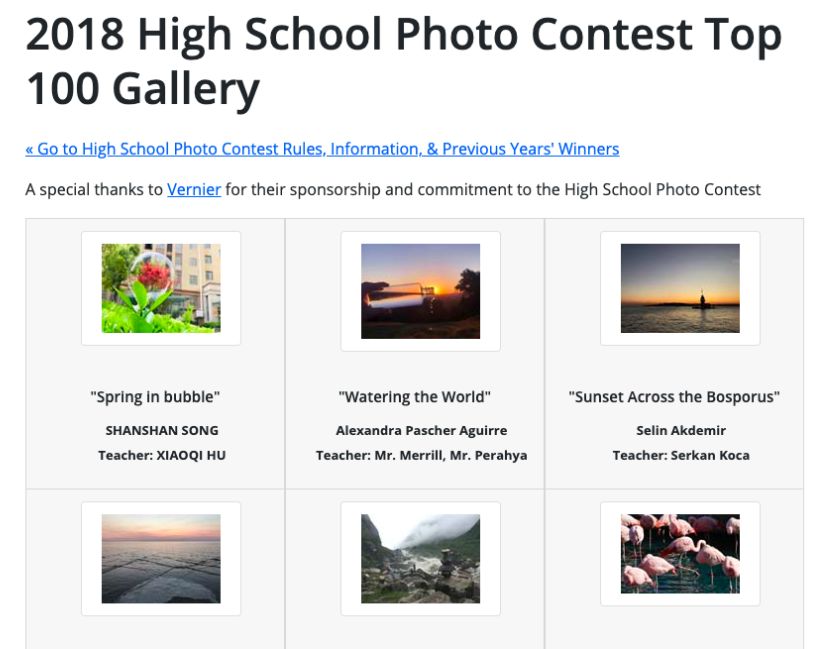/ 美国高中物理摄影大赛 /


竞赛简介▉
由美国物理教师协会AAPT主办,由参赛选手拍摄一张生活中或者特意设计的可以巧妙反应深刻物理现象、物理原理的照片,然后配上不多余250字(英文)的物理解释说明。
AAPT高中物理摄影大赛是一项针对高中生的国际比赛。多年来,该比赛为教师和学生提供了一个机会,学生们将在国际舞台上与1000多名同龄人一起参加比赛,以表彰他们的作品。
竞赛适合对象▉
9—12年级的学生,高一至高三学生,GCSE1—A2均合适
奖项设置▉
全球自然类照片:前三名
全球设计类照片:前三名
全国优秀照片:设计类和自然类的前50名
所有参赛选手都会获得参与证书,所有获奖选手会另外获得对应奖项的证书。
参赛时间▉
以2018-2019赛季为例:
报名时间:2019年3月1日至2019年5月15日之间递交作品
AAPT公布最终结果的时间:2019年7月
比赛规则▉
评分细则
AAPT物理组委会的老师将会从所有收到的照片里选出前100名(评分中图片中所反映的物理现象占60%,照片相对应的文字描述占40%),将会在我们的下届AAPT会议中展出,并且评出最后的冠亚军。
作品种类
自然类照片:日常生活中自然出现的包含物理原理的照片
设计类照片:通过人为设计从而展现特定物理概念的照片
作品要求
以表达物理现象和原理为内涵,凡自然发生或创意安排的现象所拍摄的图片均可,用少于250字的篇幅说明有关图片所表达的物理现象。每张照片要包含一个标题。
高分辨率的照片,可以被清晰的放大至10寸照片大小(至少800万像素)。
参赛作品必须为原创作品,且不得通过电脑合成或者PS。
这个比赛可以说完美地展现了同学们的科学实力与艺术素养,摒弃了传统了物理学科的枯燥形象,受到很多同学的关注和青睐,但对究竟该如何参赛还是存在很多疑惑。我们特意邀请到多才多艺的学霸摄影大师邓博老师,为大家开设全英授课美国高中物理摄影大赛全球TOP100冲刺班。

课程内容
1
第一课(授课形式:网络在线直播小班课)
1、摄影的历史、概念、著名摄影家及作品
2、摄影机的构造及影片成像原理
3、感光度、快门、光圈的关系及原理
4、焦距及对焦的方式
5、自动、半自动、手动模式下的摄影技巧
第二课(授课形式:网络在线直播小班课)
1、回顾上节课内容,点评课后练习作业
2、构图的技巧及应用
3、摄影作品的管理与发布
4、镜头的种类、特点及选择
5、光线的种类及应用
6、色彩及白平衡
第三课(授课形式:网络在线直播小班课)
1、牛顿力学:
Falling Objects and Projectile Motion; Circular Motion, the Planets, and Gravity; Energy and Oscillations; Momentum and Impulse; Rotational Motion of Solid Objects.
2、液体及热力学现象
The Behavior of Fluids; Temperature and Heat; Heat Engines and the Second Law of Thermodynamics.
第四课(授课形式:网络在线直播小班课)
1、电磁学
Electrostatic Phenomena; Electric Circuits; Magnets and Electromagnetism.
2、波和光学
Making Waves; Light Waves and Color; Light and Image Formation.
第五课(授课形式:网络在线直播小班课)
1、原子和原子核
The Structure of the Atom; The Nucleus and Nuclear Energy.
2、相对论及其他
Relativity; Looking Deeper into Everyday Phenomena.
第六、七课(授课形式:网络在线直播小班课)
1、练习作品赏析及点评
2、历届优秀物理摄影作品赏析及点评
第八、九、十课(授课形式:一对一网络在线直播)
一对一工作坊:摄影作品点评及参赛作品准备
导师介绍
2
邓博老师

旅居英国华人,著名托福学霸培训名师,拥有逾13年教学经验,拥有多个世界顶级名校硕士学位。摄影方面师从仰光国际摄影节创始人和执行主席法国著名摄影师Christophe Loviny,新加坡总理李显龙官方照片摄影师Alan Lim,以及国内著名青年摄影师Qiuying Zhao。
线上课程安排
3
在线课程安排
日期
上课时间
上课形式
8月23日
周五
19:00--21:00
在线班课
8月30日
周五
19:00--21:00
在线班课
9月6日
周五
19:00--21:00
在线班课
9月13日
周五
19:00--21:00
在线班课
9月20日
周五
19:00--21:00
在线班课
9月27日
周五
19:00--21:00
在线班课
10月3日
周四
10:00--12:00
在线班课
一对一
摄影工作坊
时间经老师和学生在第七节课结束前协商确定
在线一对一2H
一对一
摄影工作坊
在线一对一2H
一对一
摄影工作坊
在线一对一2H
备注:线上授课,满四人开班,上课时间可微调。
导师作品赏析
4

























注:以上所有照片均为邓博老师个人属有,请勿盗用,谢绝转载~
课程费用
5
15800元/位
报名预约
6
微信联系 留学汇小助手 ,长按下方二维码或搜索微信号“liuxuehuiS”,添加 留学汇小助手 为好友 。联系 留学汇小助手 可索取邓博老师之前摄影讲座回顾。

历年获奖作品例举
7
2018全球自然类一等奖获奖作品

Magic Light by YINING LU
Penny grass is a tiny, umbrella like grass. which cannot live without water. I took this picture just after it was watered in the morning. I was deeply impressed and attracted. It is colorful and glittering. The flowers in the droplet of water were formed by the refraction of light. This is a perfect example of the path changing of the light rays due to the different index of refraction of air and water. when light passed from one transparent medium into another, part of the incident light is reflected at the boundary. The rest changed their directions.
The droplet is not a perfect spherical one owing to the gravity. It is much more like one planoconvex lens. The diameter is only half a centimeter around. The incidence light first reflected from the real flower into the water and changed direction and focused on the focal point to form the image. The droplet just like a convex lens. The position of the real flower and the droplet should be parallel to each other to get a clear and complete real image. We can see a sharp image, when the eye is placed behind the image.
The sunflower is real and has three dimensions, so the focal planes are not only one. That is why the images are not quite the same as the object. The real images are upside down which can be explained by tracing the ray. The size of the image is depends on the distance between the flower and the droplets according to the lens equation.
The beautiful flowers in the droplets can be seen is the coincidence of the right incidence angle of light, the right angle of my eyes. when I moved slightly, it disappeared like a magic. Beauty is everywhere, for our eyes, not the lack of beauty, but the lack of discovery!
2018全球设计类一等奖获奖作品

Finger Pickin' Good by Nicolas Gonzalez
This is a single image taken from inside a guitar. If you’ve ever taken a panorama on your phone, you know that capturing moving objects can make them appear distorted. This is because the entire photo isn’t being captured instantaneously, so the same object can be in different places in the same shot. What you may not know is that normal photos we take with our phones use this same process and are subject to the same errors. Capturing an image one column at a time is often too quick of a process to be noticeable, but the fast moving guitar strings in this photo manage to outrun the sensor. From the peaks of these waves to their troughs, the guitar string has physically moved downward, and time has passed. The moving guitar strings are first harmonic standing waves, secured only at each end of the guitar. The apparent ‘wavelengths’ of these waves are actually indicative of their frequency. The thicker, more massive strings towards the top of the image move at a lower frequency than the thinner, faster moving strings at the bottom. In the amount of time it took for my camera’s sensor to capture this photo, the thickest string reached its peak only three times, while the thinnest reached its peak a whopping six times. In contrast, there are no distortions present in the background, simply because it doesn’t move as the image is captured.



点击“阅读原文”获取你的专属学术定制
